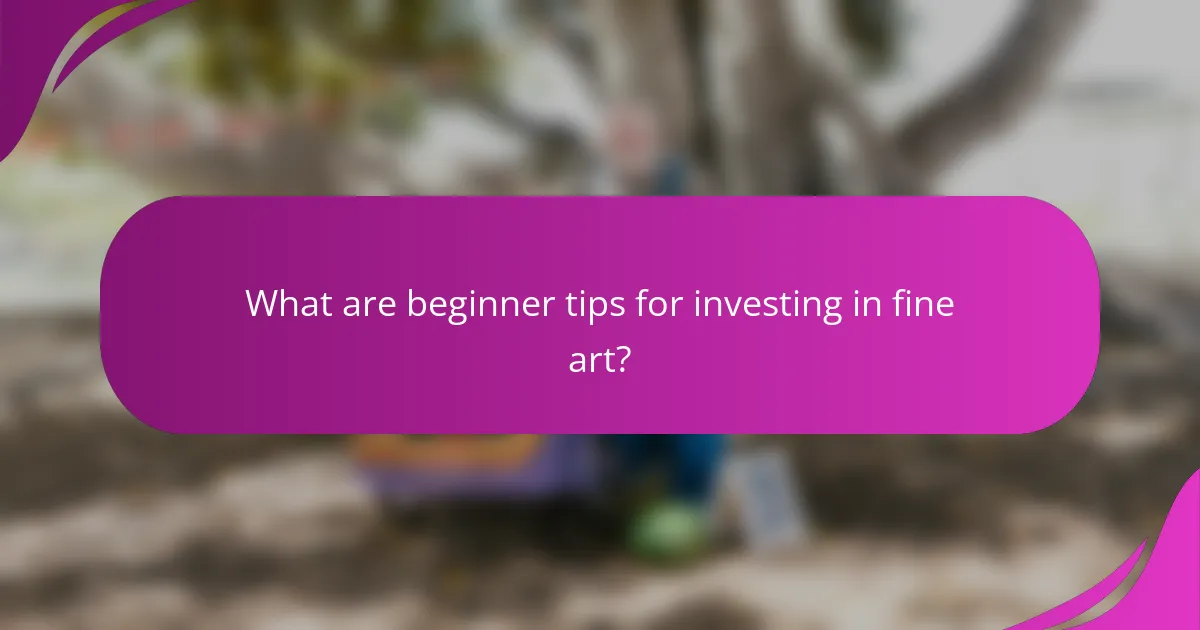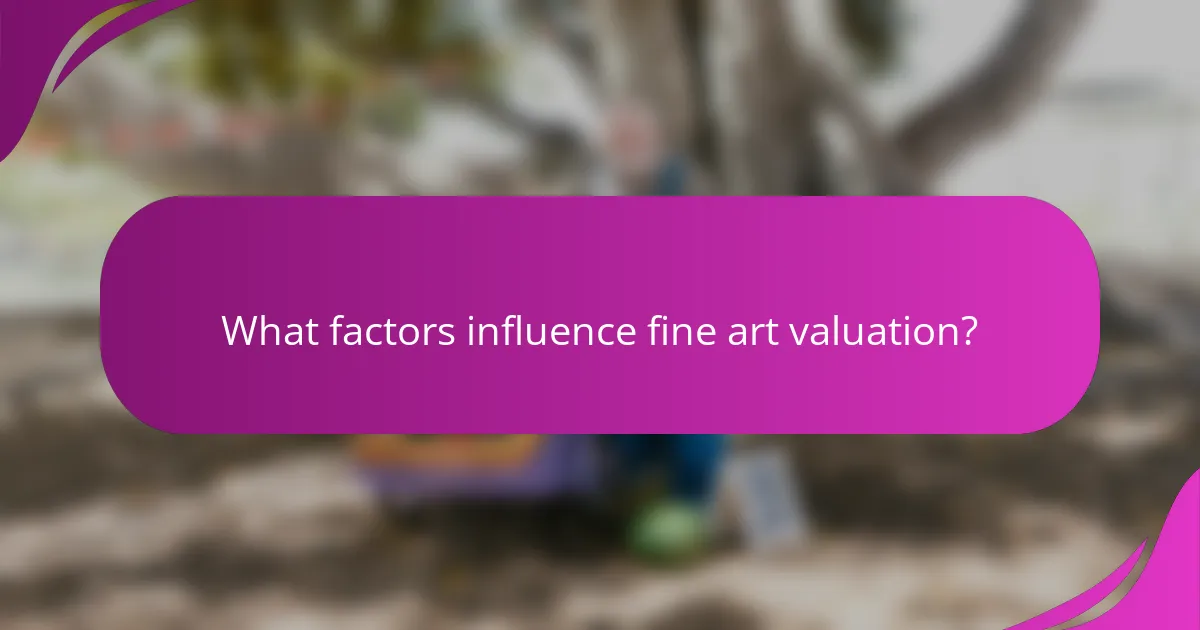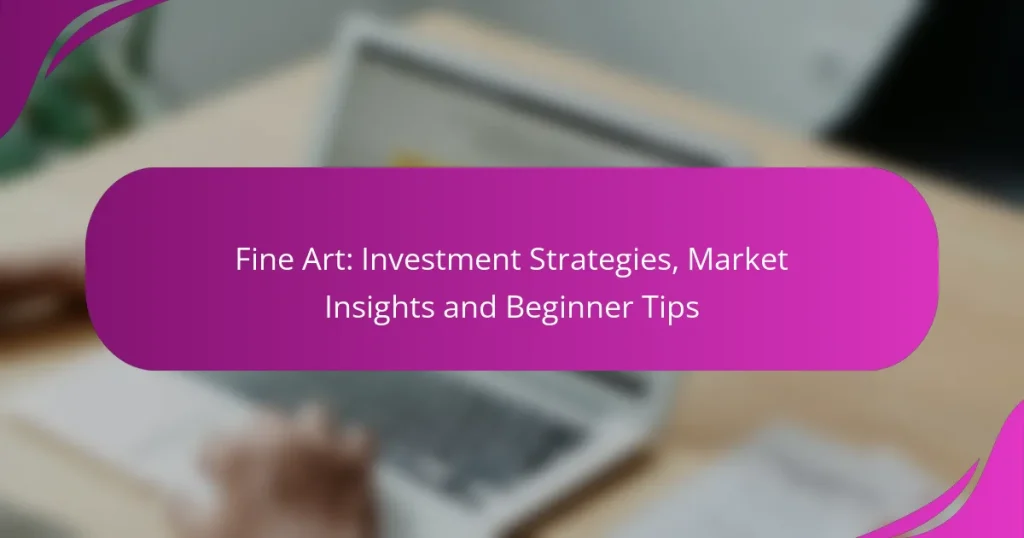Investing in fine art can be a rewarding venture, offering both aesthetic enjoyment and potential financial returns. By focusing on long-term appreciation, market trends, and emerging artists, investors can make informed choices that enhance their portfolios. Understanding the nuances of the art market and seeking professional guidance are essential steps for beginners looking to navigate this complex landscape.

What are the best investment strategies for fine art?
The best investment strategies for fine art focus on long-term appreciation, diversification, market timing, and thorough analysis of condition and provenance. By understanding these strategies, investors can make informed decisions that enhance their portfolios and mitigate risks.
Long-term appreciation
Long-term appreciation in fine art involves acquiring pieces that are expected to increase in value over time. This strategy typically requires patience, as the art market can be volatile and influenced by trends. Investors should consider works by established artists or those with a growing reputation, as their pieces often appreciate more reliably.
Researching historical sales data and auction results can provide insights into which artists and styles have shown consistent growth. For example, works by renowned artists like Picasso or Warhol have historically seen significant appreciation, often reaching millions of dollars.
Diversification of artists
Diversifying across different artists can help mitigate risks in fine art investment. By investing in a range of artists from various movements and styles, investors can protect themselves against market fluctuations affecting a specific artist or genre. This approach allows for a balanced portfolio that can withstand downturns in particular segments.
Consider allocating funds to emerging artists alongside established names. Emerging artists may offer lower entry prices with high potential for appreciation, while established artists provide a stable foundation. A balanced mix can enhance overall returns while minimizing exposure to market volatility.
Market timing
Market timing in fine art involves making purchases or sales based on current market conditions and trends. Understanding when to buy or sell can significantly impact investment returns. Investors should monitor auction schedules, gallery exhibitions, and economic indicators that influence the art market.
For instance, purchasing during a market downturn can yield better prices, while selling during a high-demand period can maximize profits. Staying informed about art fairs and major exhibitions can also provide insights into emerging trends and potential investment opportunities.
Condition and provenance analysis
Condition and provenance analysis are critical factors in determining the value of fine art. The condition of a piece affects its marketability and potential appreciation, with well-preserved works commanding higher prices. Investors should assess any restoration work and overall physical state before purchasing.
Provenance, or the history of ownership, adds to a piece’s value and authenticity. A clear and documented provenance can enhance an artwork’s desirability, while pieces with uncertain histories may carry risks. Always verify provenance through reliable sources to ensure the integrity of the investment.

How to assess the fine art market in the US?
To assess the fine art market in the US, consider key factors such as market trends, price indices, and auction results. These elements provide insights into the current state and future potential of art investments.
Market trends analysis
Analyzing market trends involves observing shifts in buyer preferences, emerging artists, and popular styles. For instance, contemporary art has gained significant traction, often outperforming traditional genres in sales.
Keep an eye on economic indicators, as they can influence art purchasing behavior. During economic growth, art sales typically rise, while downturns may lead to decreased demand.
Art price indices
Art price indices track the performance of various art segments over time, helping investors gauge market health. The Mei Moses index and the Artprice index are two widely recognized benchmarks that reflect price changes across different categories.
When evaluating these indices, consider factors such as the frequency of sales and the diversity of artists represented. A well-rounded index can provide a more accurate picture of market trends.
Auction results evaluation
Auction results are critical for assessing the fine art market, as they reveal real-time demand and pricing. Major auction houses like Sotheby’s and Christie’s publish detailed results that can be analyzed for insights into which artists and styles are currently in favor.
Review the sell-through rates, which indicate the percentage of lots sold versus offered. A high sell-through rate suggests strong demand, while a low rate may signal market saturation or declining interest.

What are beginner tips for investing in fine art?
Beginner tips for investing in fine art include understanding the market, focusing on emerging artists, and seeking professional advice. These strategies can help you navigate the complexities of art investment while minimizing risks.
Start with emerging artists
Investing in emerging artists can be a smart strategy for beginners. These artists often have lower price points, allowing you to acquire works at a more accessible cost, typically ranging from a few hundred to several thousand dollars.
Look for artists who are gaining recognition through exhibitions, awards, or social media presence. This can indicate potential for value appreciation as their careers progress.
Attend art fairs and exhibitions
Art fairs and exhibitions provide excellent opportunities to discover new talent and network with other collectors. Visiting these events allows you to see artworks in person, which can be crucial for assessing quality and authenticity.
Consider attending local art fairs or larger international events, as they often feature a diverse range of artists and galleries. Engaging with artists and gallery owners can also provide insights into market trends and investment potential.
Consult art advisors
Working with art advisors can help you make informed decisions in your investment journey. These professionals offer expertise in evaluating artworks, understanding market dynamics, and identifying potential investment opportunities.
When choosing an advisor, look for someone with a strong track record and connections in the art world. A good advisor can help you avoid common pitfalls and guide you toward artworks that align with your investment goals.

What factors influence fine art valuation?
Fine art valuation is influenced by several key factors, including the artist’s reputation, the rarity of the artwork, and its historical significance. Understanding these elements can help collectors and investors make informed decisions about purchasing and selling art.
Artist reputation
The reputation of an artist is one of the most significant factors in determining the value of their work. Established artists with a strong track record in exhibitions and sales typically command higher prices than emerging artists. Collectors should consider the artist’s career longevity, critical acclaim, and market demand when evaluating potential investments.
For example, works by renowned artists like Pablo Picasso or Vincent van Gogh can sell for millions, while lesser-known artists may only reach a few thousand dollars. Investing in art from artists with a growing reputation can yield substantial returns over time.
Artwork rarity
Rarity plays a crucial role in fine art valuation. Unique pieces or limited editions tend to be more valuable than mass-produced works. The fewer the available pieces, the higher the demand, which can significantly increase an artwork’s market price.
Collectors should assess the availability of similar works and consider factors such as the number of editions produced and the artwork’s provenance. For instance, a limited edition print from a well-known artist may be worth considerably more than an open edition print.
Historical significance
Historical significance can greatly enhance an artwork’s value. Pieces that are associated with important cultural movements, events, or figures often attract higher prices due to their context and storytelling potential. Art that reflects pivotal moments in history or embodies a particular style can resonate more with collectors.
When evaluating historical significance, consider the artwork’s place within art history, its influence on future artists, and its relevance to current social issues. For example, artworks from the Harlem Renaissance or the Abstract Expressionist movement are often highly sought after due to their cultural impact.

How to choose the right art for investment?
Choosing the right art for investment involves aligning personal taste with market trends and evaluating the potential for appreciation. Consider factors such as the artist’s reputation, current demand, and your own aesthetic preferences to make informed decisions.
Personal taste alignment
Investing in art that resonates with your personal taste is crucial. If you genuinely appreciate a piece, you are more likely to enjoy it while it appreciates in value. This emotional connection can also guide you in making decisions about future acquisitions.
Consider creating a collection that reflects your style, whether it’s contemporary, classical, or abstract. This alignment not only enhances your enjoyment but can also attract buyers who share similar tastes when you decide to sell.
Market demand assessment
Assessing market demand is essential for a successful art investment. Research current trends, popular artists, and emerging movements to identify what is sought after. Attend galleries, art fairs, and auctions to gauge buyer interest and pricing.
Utilize online platforms and auction results to track sales data and understand which types of art are appreciating. Look for pieces by artists who have a growing reputation or those who are gaining traction in the market.
Investment potential evaluation
Evaluating the investment potential of art requires analyzing various factors, including the artist’s history, the rarity of the piece, and its condition. Look for artworks that have a track record of appreciation and are likely to maintain or increase their value over time.
Consider consulting with art advisors or appraisers to gain insights into the potential future value of specific pieces. Be cautious of overpaying; aim to acquire art at a price that allows for a reasonable margin when reselling.

What are the risks of investing in fine art?
Investing in fine art carries several risks, including market volatility and liquidity challenges. These factors can significantly impact the value and ease of selling art pieces, making it essential for investors to understand them before committing funds.
Market volatility
The fine art market is known for its fluctuations, which can be influenced by economic conditions, trends in taste, and the emergence of new artists. Prices can vary widely, sometimes experiencing sharp increases or decreases over short periods. For instance, a piece by a trending artist may appreciate quickly, while works by less recognized artists may stagnate or decline.
Investors should monitor market trends and be prepared for the possibility that their art investments may not appreciate as expected. Engaging with art market reports and attending auctions can provide insights into current valuations and emerging trends.
Liquidity challenges
Liquidity refers to how easily an asset can be sold for cash without significantly affecting its price. Fine art typically has lower liquidity compared to stocks or bonds, meaning it can take time to find a buyer willing to pay a desirable price. This can be particularly challenging during economic downturns when buyers may be scarce.
To mitigate liquidity risks, investors should consider diversifying their art collections and maintaining a balance between high-value pieces and more accessible works. Additionally, working with reputable galleries or auction houses can help facilitate sales when needed.


